OPENING ADDRESS, IJ-6 THE SIXTH CONFERENCE ON INNOVATION JOURNALISM
David Nordfors
Founding Executive Director,Tthe VINNOVA-Stanford Research Center of Innovation Journalism
H-STAR Institute
Stanford University
18 May 2009, Stanford University
Welcome to IJ-6, the Sixth Conference on Innovation Journalism.
Thank you all for coming here, especially you who have travelled all the way from Sweden, Finland, Estonia, Slovenia, Pakistan, Israel, France, Chile, Mexico, UK, Korea and Kenya.
Thank you also to the funding organizations that are making the Innovation Journalism Initiative and IJ-6 possible. Above all, thanks to VINNOVA, the National Swedish Agency for Innovation Systems, that initiated the collaboration with Stanford in 2004, and who partnered with Stanford in upgrading the Innovation Journalism program to a research center this year - the VINNOVA-Stanford Research Center of Innovation Journalism. We are now a part of H-STAR, the Human Sciences and Technologies Advanced Research Institute here at Stanford, and we are really looking forward to build a solid body of research that will add further traction to our other activities. Thanks to the agencies and foundations that have made it possible for journalists and researchers from around the world to join the center at Stanford: the Helsingin Sanomat Foundation, Sitra and Tekes in Finland, the Competitive Support Fund and the USAID in Pakistan, Ad Futura in Slovenia and Conacyt in Mexico.
These are turbulent times for the media. When we started the Innovation Journalism program in 2004, the word 'blog' was quite new. Inside the newsrooms, people were discussing if blogs were to be taken seriously or not. Our Injo Fellow Marcus Lillkvist wrote the first story in Wall Street Journal on that blogs were getting ads, and that some blogs were earning enough money to hire people to work with them. The blogs contained mostly news from the paper publications. Today, online publication is in the lead.
In 2005 we recorded a roundtable discussion with Vint Cerf, Whit Diffie and a number of other experts and journalists. On the cover we wrote 'journalism stands at the crossroads of redefinition'. Vint was in the middle of switching jobs, going from Worldcom to Google. Since then, nearly all journalists in that video have switched jobs. Vint is still at Google.
The media industry is facing a business challenges, their business model is bust in several ways. Controlling the infrastructure for distribution of content was the key to making money. Control the production, control the distribution, control the content. When your channel of information gets public attention, sell that attention to advertisers by letting them pay to push their info through your infrastructure. People could control printing presses, fleets of trucks distributing freshly printed paper, broadcast concessions. But they can not control the Internet. In fact, as we move toward Net Neutrality - a concept promoted by Vint and many people in the Internet culture, where those who control the infrastructure of the Internet are forced to not censor the content - it may become illegal to try doing it. The trend in the media just now is to move away from vertical integration. Those who produce content are moving away from controlling the infrastructure, such as is the case with blogs. And those who control the infrastructure are moving away from producing and controlling the content, such as the companies providing the cables, the ISPs, and companies offering tools for aggregating and organizing information and transactions, such as Google, Facebook, or eBay.
In the eighties software industry broke out from the hardware industry. In the nineties network services broke out from the network infrastructure providers. Perhaps we are seeing now how content is breaking out of the media. We will have an industry providing the infrastructure for spreading content - like Facebook, Google or eBay - and other industries providing content, among them the journalism industry. A number of these players are earning their money by selling our attention to advertisers, and we are offered a greater variety of products and services in return for directing our eyballs here or there. Our attention used to give us news and entertainment. Now it's giving us tools as well, for example Blogs, word processing, search engines. That's actually not bad. But it will be bad if it ends up with that attention gives us only tools, and no good content. We need both.
This also means that the definition of journalism needs to be looked over.
According to the Oxford dictionary on the Internet, AskOxford.com, a journalist is, I quote, "a person who writes for newspapers or magazines, or prepares news or features to be broadcast on radio or television". Ironically, Oxford's Internet dictionary does not say a word about journalism on the Internet. But just pushing in the Internet in that sentence won't solve the problem. The problem is, we have been used to identifying the content with the carrier. This is understandable, because that was the way it was. But today, no more. Here is another example of how we have identified the content with the carrier: LPs and CDs used to mean music. Today CDs are no more pieces of plastic with music information on them. We rip the music and toss the plastic. LPs represent memories of old times, when vinyl was music and vice versa. But the cat is out of the bag, the information has broken free, the vertical integration is broken, and all the kings horses and all the kings men can't put Humpty back together again, with the possible exception of Steve Jobs, who seems to have brought back vertical integration to some extent with the iMac, and with the iPod, iPhone and iTunes. He is earning good money on it and people like it. So let's be careful with saying that vertical integration is gone from the news business forever. But we won't go back to old times.
We must look at how we can redefine journalism. It still means something, even if it is not brought to us on paper, through the radio or TV. It remains valuable. The old definitions related journalism to the medium. How about defining journalism by its relations to its constituency? How about talking about what journalism does for people, rather than stating which infrastructure it uses for spreading the information? For example, we can define journalism as the production of news stories, bringing public attention to issues of public interest. Journalism gets its mandate from the audience. It is required to act in the interest of the audience. This was valid for good newspapers, and it remains to be valid without newspapers. We are talking about the principles of journalism, that's what defines journalism. So when we are talking about the crisis in the media industry, we are perhaps not trying to address how to save the old business models, or how media should continue to be controlled by those who produce the content. We are talking about the importance of finding business models for the principles of journalism.
We need to adopt new definitions and find new models, or things might get worse. For example, in some countries around the world, public service broadcast is payed for by placing a fee on TVs, radios and other equipment used for taking part of public service content. The companies that collect these fees are very committed to the task. Now that public service TV is broadcast online, they are stating their intentions to collect public service fees on all personal computers. I guess all cell phones will soon be next. How much sense does that make? And as long as the production of public service journalism is payed for by these fees, the public service news organizations will be stepping on their own eggs when reporting on any Internet issues.
Which brings us to the next issue. Given that journalism will develop a strong innovation system, enabling it to continuously renew itself, so that it like the rest of the information industry is always aiming at the next product rather than aiming to prolong the lives of its earlier ones, what is its mission in society?
Society is going through a fundamental change. We are getting less driven by doing more of the same, and more driven by making new things replace the old. Curt Carlson, who is speaking later today, defines innovation as the process of creating and introducing new value in society. That's what is driving society more and more, not doing more of the old stuff. Power structures are shifting as a consequence. In a more of the same economy, power is in regulation. When society is driven by the introduction of new things, innovation often trumps regulation. Look for example at music. Innovation means that everything gets more connected. In the more of the same economy, it's easier to divide the labor, to establish professions following established routines, to write textbooks about how things were always done and how they should continue to be done. In the more of the same economy, people can group together with other people doing the same things as themselves, focus on that part and not communicate much with the rest of the world. In the innovation economy, however, everything is changing, technologies, business models and policies shape each other interactively, and everything becomes everyones business.
People in society need journalism to tell them the story of how the innovation economy hangs together, where the power is, how science, technology, business and politics co-evolve, and how this depends on and changes cultures. Doug Engelbart is suggesting we need to be connected in a collective intelligence, so that we can solve fundamental challenges, such as global warming, pandemics, the threat of nuclear wars, and so on. But our communication is limited by our shared language. How do we collectively develop words and stories that enable us to talk about the things we benefit best from talking about, and which enable us to find solutions, build wealth and happiness? Journalism is an obvious player, Doug has said he sees it as the perception system of our collective intelligence. Not the sensory system, but the perception system.
When we look it how we are interacting collectively today, it is valid to ask if we are heading for collective intelligence or if we are heading for collective neurosis. Here, again, the importance of matching business models and principles of journalism are important. We definitely need good business models promoting the principles of journalism, offering an incentive for directing public attention to issues of public interest, and facilitating a public dialogue which will deliver the greatest value to the audience. Without good business models for journalism, the players for public attention will soon be dominated not by those representing the audience - i.e. the journalists - but by those representing the sources - i.e. PR. I like both PR and journalism, they are both needed. They are both a part of the ecosystem that will hopefully direct our collective attention to maximize our collective intelligence.
In todays innovation economy people need professional news organizations, driven by incentives to represent the interest of the audience, to cover innovation so that people can engage, and can create maximum value for themselves and others. It needs to interact with other professionals, representing stakeholders in the innovation ecosystem, who also are playing for the public attention. Together they form the innovation communication ecosystem.
That is what the Innovation Journalism conference is about, and we will today and tomorrow, with the help of the Innovation Journalism Fellows 2009, discuss various aspects of how journalism can best play its part in the innovation economy. The workshops are defined and moderated by the Fellows, who will be summarizing some bullets on best practices. We will be doing it in two ways. Today we are looking at themes - "How tos". Tomorrow we will be meeting journalists who have covered innovation well - our Injo Picks 2009 - and talk with them about how things are done the best way.
All the workshops are organized by our Injo Fellows 2009: Christian Borg, Ellen Andersson, Fredrik Wass, Jörgen Lindqvist, Kerstin Sjöden and Mats Lewan from Sweden. Anna Kattan, Anu Partanen, Juha-Pekka Tikka and Jussi Rosendahl from Finland. Afzal Bajwa, Hamza Habib, Mubarak Zeb Khan and Sarah Hasan from Pakistan. Sabina Vrhnjak from Slovenia and David Luna from Mexico. Both Slovenia and Mexico are in the program for the first time this year.
This year we also have for the first time a special academic track on the the innovation ecosystems and the news. which takes place on wednesday in parallel with other interesting talks from the field. Just like innovation is new as a keyword for journalism, journalism is new as a keyword for research on innovation. I hope we will get a good dialogue between journalists and academics, it is really needed in order to move forward. The people who have put together the academic track are Vilma Luoma-aho, our Helsingin Sanomat Foundation Visiting Injo Researcher from the university of Jyväskylä in Finland, Marc Ventresca, Professor at Said Business School in Oxford and Senior Scholar at the VINNOVA Stanford Research Center of Innovation Journlaism at Stanford; and Turo Uskali from the University of Jyväskylä in Finland, former visiting researcher with us here at Stanford.
We should also be very grateful to Johanna Mansor, without who two stones would not be standing on top of each other here today. Thanks to John Joss, who is checking all the texts by all the Fellows and will be taking part in the moderation of the conference. We also are very grateful to all of our members on the Directors Advisory Board: Vint Cerf, Curt Carlson, David Demarest, Anders Flodstrom, Don Kennedy and Jacob Ziv, and the Program Advisors of our Center who are here today, who each are carrying a part in building the global initiative: Violeta Bulc, Turo Uskali, Amir Jahangir and Rick Horning. Final thanks to our friends that have given us advice on the conference: Mei-Lin Fung, Allison Murdock, Lisa Friedman, Laszlo Gyorffy.
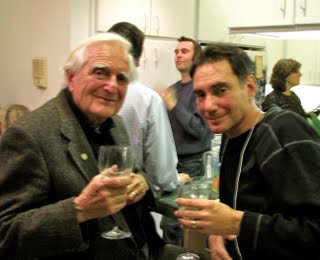

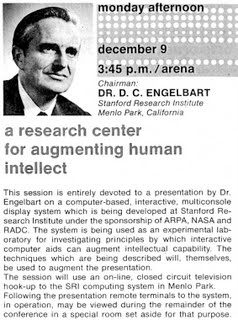
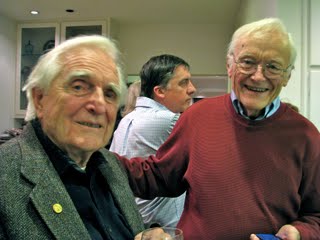





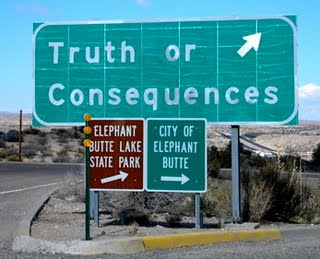
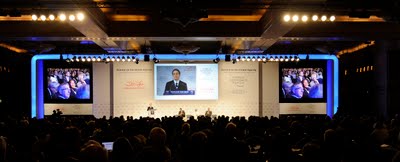


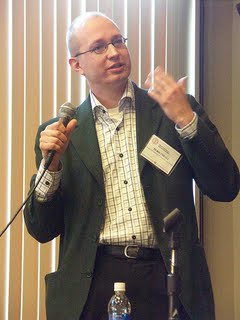
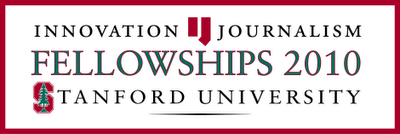
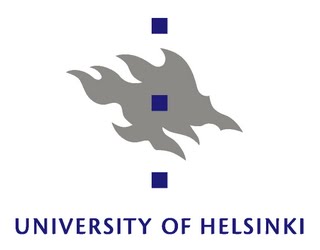 5. It is supported by
5. It is supported by 




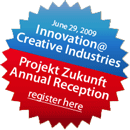



 P/IP and co-founded the Internet-culture. We had a surprise visit by Doug Engelbart, who sat in with us on stage for the Q&A. Doug invented the computer mouse, as a part of demonstrating the first computer system with GUI, videoconferencing, teleconferencing, email and hypertext. Doug's lab at SRI was responsible for more breakthrough innovation than possibly any other lab before or since.
P/IP and co-founded the Internet-culture. We had a surprise visit by Doug Engelbart, who sat in with us on stage for the Q&A. Doug invented the computer mouse, as a part of demonstrating the first computer system with GUI, videoconferencing, teleconferencing, email and hypertext. Doug's lab at SRI was responsible for more breakthrough innovation than possibly any other lab before or since.












